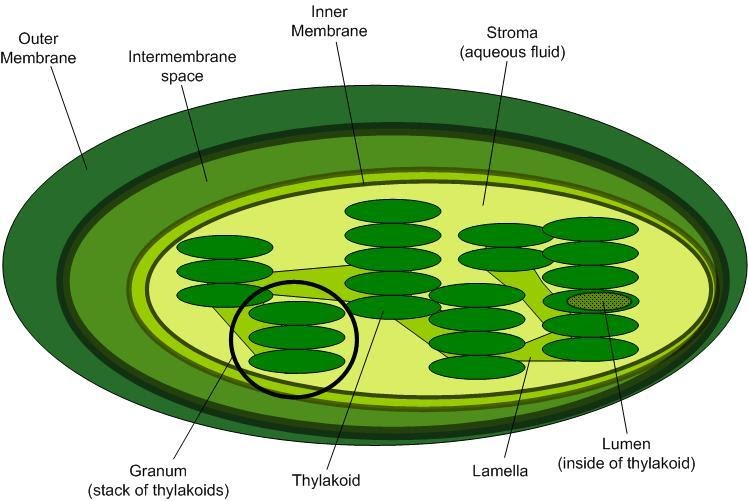
Which cells contain chloroplasts?
Answer
419.1k+ views
Hint: Chloroplasts are usually found in green plants and algae. Chloroplasts are also found in photosynthetic tissues that do not appear green in color, such as brown blades of giant kelp or the red leaves of certain plants. chloroplast is a pigment based on plastid types.
Complete answer:
Chloroplasts contain chlorophyll and carotenoid pigments that are necessary for photosynthesis in light energy.

Majority of the chloroplast of green plants are found in the mesophyll cells of leaves. The organelles are lens-shaped, oval, spherical, discoid or even ribbon-like and vary in length from \[5 - 10{\text{ }}mm\]and in width from\[2 - 3{\text{ }}mm\]. Their number varies from \[1\] per cell as example – Chlamydomonas, green alga.
Like mitochondria chloroplasts are also double membrane organelle. One of the membranes is the inner membrane which is less permeable. The space limited by the chloroplast's internal membrane is referred to as the stroma. A number of organized flattened membranous sacs called as thylakoids are present inside the stroma. Thylakoids are arranged in stacks like the piles of coin shaped known as grana. Also, there are flat membranous tubules called the stroma lamellae which connects the thylakoids of different grana. Chloroplast stroma contains a wide range of enzymes necessary for carbohydrate and protein synthesis. The membrane of thylakoids is enclosed by a space which is called lumen.
The stroma also contains small, double stranded DNA molecules and ribosomes. The ribosomes of chloroplasts are smaller \[70s\] than the cytoplasmic ribosomes \[80s\]. As we discussed that chloroplasts are required for photosynthesis mechanisms beside providing pigment to plants, now let us see the machinery of photosynthesis and how it works.
The thylakoid membrane houses chlorophylls and different protein complexes, including photosystem I, photosystem II, and ATP synthase which are specialized for light-dependent photosynthesis. Chloroplasts have their own DNA often known as DNA. Chloroplast DNA is not associated with true histones in red algae, similar proteins that tightly pack each chloroplast.
Note:
Chloroplast DNA nucleoids in the primitive red algae are clustered into the center, while the nucleoids are spread over all stroma in green plants and green algae. Not all cells in a multicellular plant contain chloroplasts. The plant cells which contain chloroplasts are mostly parenchyma cells but also collenchyma tissue have some chloroplasts. A plant cell which contains chloroplasts is typically called a chlorenchyma cell.
Complete answer:
Chloroplasts contain chlorophyll and carotenoid pigments that are necessary for photosynthesis in light energy.

Majority of the chloroplast of green plants are found in the mesophyll cells of leaves. The organelles are lens-shaped, oval, spherical, discoid or even ribbon-like and vary in length from \[5 - 10{\text{ }}mm\]and in width from\[2 - 3{\text{ }}mm\]. Their number varies from \[1\] per cell as example – Chlamydomonas, green alga.
Like mitochondria chloroplasts are also double membrane organelle. One of the membranes is the inner membrane which is less permeable. The space limited by the chloroplast's internal membrane is referred to as the stroma. A number of organized flattened membranous sacs called as thylakoids are present inside the stroma. Thylakoids are arranged in stacks like the piles of coin shaped known as grana. Also, there are flat membranous tubules called the stroma lamellae which connects the thylakoids of different grana. Chloroplast stroma contains a wide range of enzymes necessary for carbohydrate and protein synthesis. The membrane of thylakoids is enclosed by a space which is called lumen.
The stroma also contains small, double stranded DNA molecules and ribosomes. The ribosomes of chloroplasts are smaller \[70s\] than the cytoplasmic ribosomes \[80s\]. As we discussed that chloroplasts are required for photosynthesis mechanisms beside providing pigment to plants, now let us see the machinery of photosynthesis and how it works.
The thylakoid membrane houses chlorophylls and different protein complexes, including photosystem I, photosystem II, and ATP synthase which are specialized for light-dependent photosynthesis. Chloroplasts have their own DNA often known as DNA. Chloroplast DNA is not associated with true histones in red algae, similar proteins that tightly pack each chloroplast.
Note:
Chloroplast DNA nucleoids in the primitive red algae are clustered into the center, while the nucleoids are spread over all stroma in green plants and green algae. Not all cells in a multicellular plant contain chloroplasts. The plant cells which contain chloroplasts are mostly parenchyma cells but also collenchyma tissue have some chloroplasts. A plant cell which contains chloroplasts is typically called a chlorenchyma cell.
Recently Updated Pages
The correct geometry and hybridization for XeF4 are class 11 chemistry CBSE

Water softening by Clarks process uses ACalcium bicarbonate class 11 chemistry CBSE

With reference to graphite and diamond which of the class 11 chemistry CBSE

A certain household has consumed 250 units of energy class 11 physics CBSE

The lightest metal known is A beryllium B lithium C class 11 chemistry CBSE

What is the formula mass of the iodine molecule class 11 chemistry CBSE

Trending doubts
Fill the blanks with the suitable prepositions 1 The class 9 english CBSE

Given that HCF 306 657 9 find the LCM 306 657 class 9 maths CBSE

Difference Between Plant Cell and Animal Cell

Draw an outline map of India and mark the following class 9 social science CBSE

What is the difference between Atleast and Atmost in class 9 maths CBSE

Differentiate between the Western and the Eastern class 9 social science CBSE




